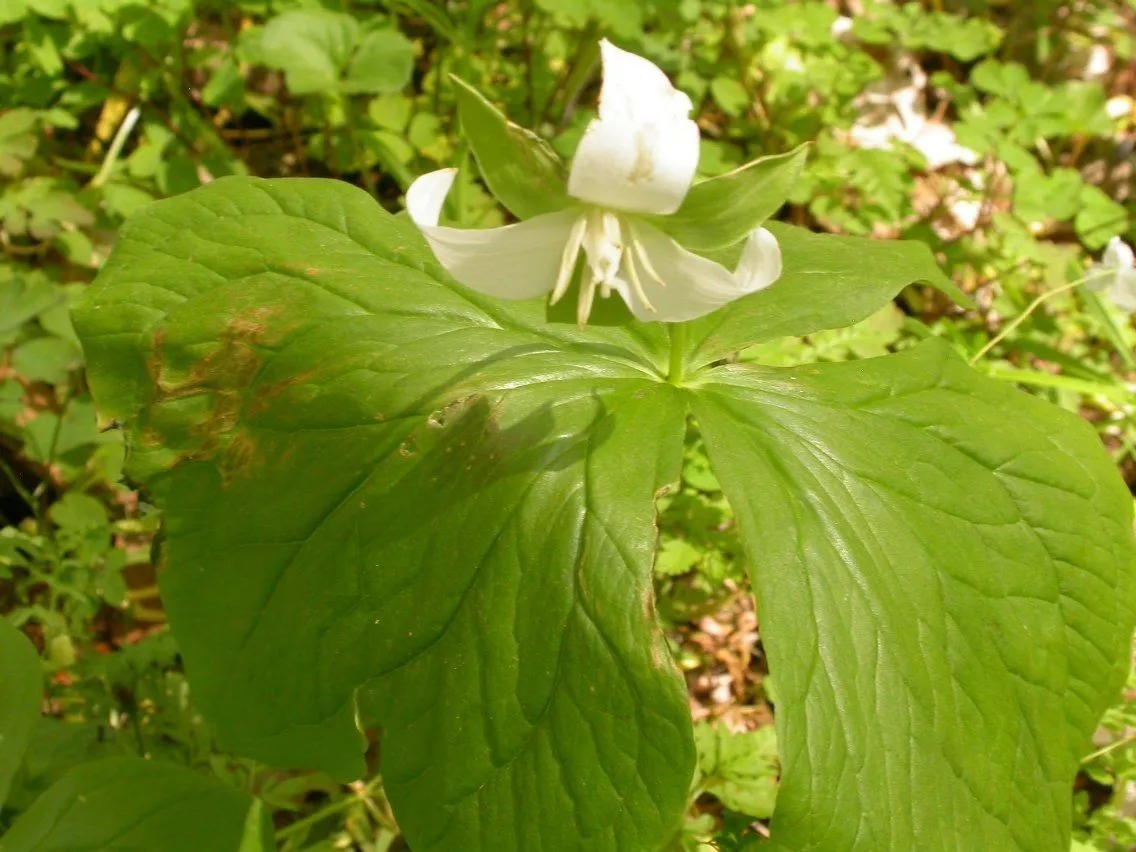
Author: Raf.
Bibliography: Autik. Bot.: 133 (1840)
Year: 1840
Status: accepted
Rank: species
Genus: Trillium
Vegetable: False
Observations: S. Ontario to EC. U.S.A.
The Nodding wakerobin, scientifically known as Trillium flexipes, is a captivating plant species belonging to the family Melanthiaceae. This perennial herb is known for its elegant, drooping flowers, which have earned it the common name “nodding” wakerobin.
Trillium flexipes is native to a range extending from Southern Ontario through to the East Central United States. It thrives in deciduous forests, where it can be found growing in rich, moist, and well-drained soils. The plant typically flourishes in the understory of these forests, basking in the dappled sunlight that filters through the canopy.
A distinct characteristic of the Nodding wakerobin is its unique flower structure. The flowers are solitary and typically hang at a nodding angle beneath the leaves. They display an exquisite set of three white petals, which may sometimes exhibit a pinkish hue as they age. The petals surround a center of pale yellow to white stamens and are accompanied by three green sepals that add to the plant’s intricate beauty.
The foliage of Trillium flexipes is also notable, consisting of a whorl of three broad, ovate leaves exuding a lush, verdant quality. These leaves are not only aesthetically pleasing but also serve a functional role in photosynthesis, aiding the plant’s growth and reproduction.
The Nodding wakerobin has a specific ecological significance. It is a spring ephemeral, meaning it completes its life cycle early in the year before the canopy fully develops. This adaptation allows it to take advantage of the sunlight and the early spring resources, setting it apart from many other forest plants.
Through its delicate beauty and unique nature, Trillium flexipes adds a touch of elegance to the forest floors. Though not commonly found in every woodland area, it remains a cherished species among plant enthusiasts and naturalists who seek to preserve its presence in native habitats.
The Nodding wakerobin was first described in 1840 and has since captivated botanists and nature lovers alike with its graceful demeanor and ecological niche. Its continued study and conservation are essential for maintaining the biodiversity and health of forest ecosystems where it naturally occurs.
Eng: nodding wakerobin, drooping trillium, drooping wakerobin, nodding trillium, white trillium, bent trilllium, declined trillium
Fra: trille à pédoncule incliné, trille courbé
En: Nodding wakerobin, Nodding Trillium, Drooping Trillium, Drooping Wakerobin, White Trillium, Bent trilllium, Declined trillium
Fr: Trille à pédoncule incliné, Trille courbé
© copyright of the Board of Trustees of the Royal Botanic Gardens, Kew.
© copyright of the Board of Trustees of the Royal Botanic Gardens, Kew.
Taken May 14, 2022 by Kelsey S (cc-by-sa)
Taken May 15, 2014 by EOL − Daniel Carter (cc-by-nc)
Taken Jan 1, 1900 by EOL − Gerrit Davidse (cc-by-nc-sa)
Taken Jan 1, 1900 by EOL − Gerrit Davidse (cc-by-nc-sa)
Taken Aug 2, 2022 by Judy Gray (cc-by-sa)
Taken Jan 1, 1900 by EOL − Francine Riez (cc-by-sa)
Taken Apr 16, 2004 by EOL − Steven J. Baskauf (cc-by-nc-sa)
Taken Apr 16, 2004 by EOL − Steven J. Baskauf (cc-by-nc-sa)
Taken Apr 27, 2021 by Kolter Kiess (cc-by-sa)
Taken May 5, 2022 by Nuala Power (cc-by-sa)
Taken Jan 1, 1900 by EOL − Gerrit Davidse (cc-by-nc-sa)
Taken Apr 3, 2016 by EOL − Milo Pyne (cc-by-nc)
Taken Apr 16, 2004 by EOL − Steven J. Baskauf (cc-by-nc-sa)
Taken Apr 16, 2004 by EOL − Steven J. Baskauf (cc-by-nc-sa)
Taken Apr 12, 2006 by EOL − Steven J. Baskauf (cc-by-nc-sa)
Taken Apr 16, 2004 by EOL − Steven J. Baskauf (cc-by-nc-sa)
Growth habit>: Forb/herb
Family: Myrtaceae Author: (F.Muell.) K.D.Hill & L.A.S.Johnson Bibliography: Telopea 6: 402 (1995) Year: 1995 Status:…
Family: Rubiaceae Author: Pierre ex A.Froehner Bibliography: Notizbl. Bot. Gart. Berlin-Dahlem 1: 237 (1897) Year:…
Family: Sapindaceae Author: Koidz. Bibliography: J. Coll. Sci. Imp. Univ. Tokyo 32(1): 38 (1911) Year:…
Family: Asteraceae Author: A.Gray Bibliography: Pacif. Railr. Rep.: 107 (1857) Year: 1857 Status: accepted Rank:…
Family: Fabaceae Author: Medik. Bibliography: Vorles. Churpfälz. Phys.-Ökon. Ges. 2: 398 (1787) Year: 1787 Status:…
Family: Aspleniaceae Author: (Cav.) Alston Bibliography: Bull. Misc. Inform. Kew 1932: 309 (1932) Year: 1932…